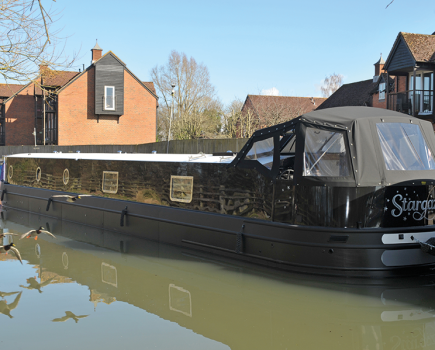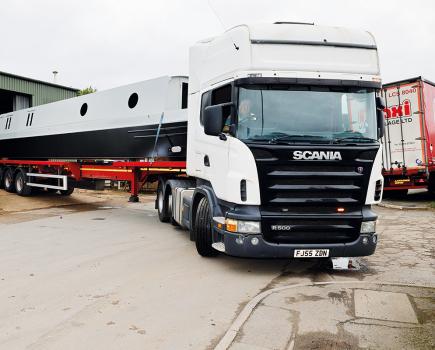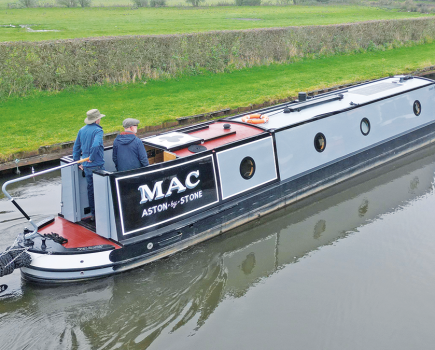Many of us like to go cruising with our partner, but sometimes in life that’s not always the way things turn out to be

Boating and boat owning mean different things to different people. For some, it’s a holiday for a week or two, for others it’s a vital escape from everyday life. For others, their boat is their full-time home. But for Rob Eddon it’s all a bit more profound even than that. He used to enjoy boating with his wife, Anne, and they owned their own boat for three years. But she was diagnosed with a rare muscle wasting condition, which eventually became so severe they had to give up boating. Then, in February 2016, she died at the age of just 57.
Rob’s twin daughters were keen for him to get back on the water – it was just a matter of proving to himself that he could single-hand safely and finding the right boat. So he took a single-handing course, and went to the Crick Boat Show to look at boats.
He found one and bought it at the show – which took a bit of imagination given that it was being shown by Knights Narrowboats in an unfinished condition. “It just felt right,” he says. And now he’s using the boat as an escape and to raise money to help fund research into Anne’s illness.

EXTERIOR
If you went to the Crick Show, there’s a good chance you’ll remember this boat because it was painted bright pink. Or at least, the bit that was painted was bright pink. But not any more. It needed to be repainted anyway because it wasn’t finished and Rob has chosen a colour scheme of two greys which looks both classic and contemporary. Cleverly, while the main part of the boat has light grey panels with a dark border, the colours swap over at the stern. The sign writing is by Andy Russell, executed to his usual high standards.
The name, Eleshanne, is made up from the initials of Rob’s grandchildren, plus Anne’s name. Chrome trim complements the look, as do the window frames, by Caldwells. There’s another reminder of Anne with the tiller pin, which is a lovely chrome A.
Eleshanne is a 57ft semi-trad, on a ColeCraft shell. They’re one of the longest and best known hull builders with a good reputation, so, as you might expect, the steelwork looks good. The boat has the recognisable ColeCraft bow which appears both shorter and wider than it actually is, and there’s a nice lift in the lines at the stern. The handrail has a finger-grip on the inside edge.
The water tank is integral to the shell under the well deck and the locker in the nose is available for storage (and access to the bow thruster tube) because the gas locker is at the rear on one side of the semi-trad deck. This makes changing gas bottles somewhat easier because you don’t have to balance on the bow. The locker on the other side is for storage.
There are a few other interesting features about the back deck. Small LED lights by the floor illuminate the deck, while a fire port in the deck board allows a fire extinguisher to be deployed without lifting the board in the unlikely event of something catching alight in the engine hole. There’s also a hot air blower to warm your feet while winter cruising, run by using excess heat from the engine which seems eminently sensible.

When you lift the deck board there are LED lights around the edge of the engine hole, so you can see what you’re doing on gloomy days or dark evenings. It’s proved such a success that Knights say they plan to make it a standard feature.
LAYOUT AND FIT-OUT
Although Rob bought the boat unfinished (there was little more inside than lined walls and the occasional bulkhead), the layout was already decided. Fortunately, it was one of the things he liked about the boat.
It’s a reverse style, with the galley at the stern. Next comes a Pullman dinette, with the saloon in the centre of the boat. A walk-through shower room follows and the cabin is at the bow. This is a typical layout for one of Knight’s spec boats (which is what this is, essentially); it’s a tried and tested formula that works well.

The fit-out uses oak combined with painted cabin sides. There’s oak veneer under the paint, so the grain still shows through. The ceiling is also painted white which helps give a sense of space. The floor is engineered oak.
The quality of workmanship looks excellent, everything fits properly and is well finished.
GALLEY
As you’d expect, steps take you down from the semi-trad deck into the galley and there are cupboards on both sides, including one for the electrics and one for the calorifier. The steps move to provide access to the lower sections. Inside, there are lovely oak block worktops which look very substantial at 40mm thick.
Inset into this there’s a Belfast sink, with a drainer routed into the worktop, that’s so deep that a normal waste would have been too close to the waterline which has meant installing a Whale Gulper pump, the type you normally see used for showers. These have a fearsome reputation for going on for years and hardly ever getting blocked, so it seems like a good choice.

The equipment includes a 12-volt Shoreline fridge, and a Dometic slot-in cooker. There’s plenty of storage and Rob has also had made a little rack for storing glasses. The galley layout, with an L-shaped run of units on one side and a shorter run on the other, means everything is close at hand.
DINETTE
The raised dinette is Pullman style and converts into a guest double bed. There’s the usual storage in the bench seats, but there’s also a wine store in the base. In addition, you can access the ballast under the dinette, just in case it needs any adjustment, perhaps because you’re storing something heavy under there.
A side hatch opposite is complete with glazed inner doors to provide extra light even on chilly days. There’s also a smart and very long grey column radiator.

SALOON
The main piece of furniture is a large sofa bed. At first, it appears to be L-shaped, but, in fact, the extra piece is a stool which is useful for providing a bit of extra seating. A TV unit is tucked under the gunwale and there’s a cupboard underneath.
The stove is in the centre of the boat. It’s a Morso, but a Swift rather than the Squirrel we see so often. The differences are few – it has a single door rather than a separate one for the ash pan, and there’s no squirrel cast on the side. The hearth looks particularly well made, with good air gaps to ensure the bulkhead behind doesn’t get hot, and there’s a double-insulated flue.

SHOWER ROOM
The shower room is a walk-through with a good sized quadrant shower at 700x800mm; it’s lined with laminate board which should be easy to keep clean and won’t leak. Beside it there are shelves and a cupboard with access to the pump. In the opposite corner a unit has another attractive oak worktop and a big round basin. There’s a heated towel rail under the gunwale. The loo is a Thetford cassette, but it’s the one with a porcelain bowl rather than plastic. Access to the cassette is under the bed in the cabin beyond, and there’s also room for two spares.

CABIN
The main cabin at the bow has an in-line bed, and even though the loo cassettes take up some of the room underneath there’s still more storage available. Here again there’s access to the ballast in case adjustment is needed.
At the head of the bed there’s a high-level cupboard and at the foot there’s a full height wardrobe. On the other side of the boat there’s a smaller unit. Steps lead up to the well deck, accessed via glazed doors.

TECHNICAL
Much of the technical equipment on this boat is by Craftsman, a name you might not be familiar with. It’s a Dutch company that makes a wide range of boating kit, from engines and bow thrusters, through tanks and portholes, to electronics. Their UK distributor is based, like Knights, at Aqueduct Marina in Cheshire, so perhaps it’s not a surprising choice.
Eleshanne has a 42hp Craftsman engine and, as with other popular narrowboat engines, it’s a marinised version of a Japanese unit, in this case a Mitsubishi industrial engine. It should certainly provide plenty of power for a boat this size. The 85kgf bow thruster is also by Craftsman.
One interesting addition is a heat exchanger on the engine, which means the radiators can make use of heat from the engine to warm the boat, a really useful feature if you’re cruising on colder days.
You might remember that there’s a hot air blower on the stern deck, which also provides heat from the engine. One concern sometimes raised about such devices is that the engine ends up over-cooled and doesn’t run hot enough; however, Knights say they’ve done the maths, checked with the manufacturer and are sure that the engine can cope with this much cooling. It certainly makes more sense to make use of the heat, rather than it just warming the canal through skin tanks.
For when the engine isn’t running, there’s a Webasto diesel boiler to provide heating and hot water.Electrical power comes from four 110Ah domestic batteries, plus one for the engine and two for the bow thruster. A TBS 3kW inverter- charger provides a 240-volt supply.
ON THE WATER
As this boat is on a ColeCraft shell the handling is as good as you might expect. It responds well to the tiller and goes exactly where it’s pointed. We turned without having to use the bow thruster, and manoeuvring in the marina also seemed precise and sure.
At the time of our visit, there was a bit of vibration from the engine at tickover, but this could have been due to the fallen leaves in the water because Rob says it hasn’t happened before or since. Otherwise, the 42hp Craftsman engine seemed perfectly fine, quietly providing all the power you’d need.
The semi-trad stern deck means there’s plenty of room for crew, and they have comfortable lockers to sit on. For the steerer, the tiller is at a nice height and the Morse control is handy.
Eleshanne:
Length: 57ft
Style: Trad-stern
Berths: 6
Layout: Reverse
Power: Craftsman 43hp
You can read more boat tests here:
Image(s) provided by:
Archant







